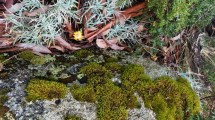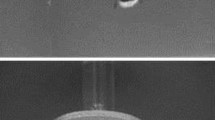Summary
This note surveys the current knowledge of the existence of acute zones in insects' eyes in relation to beeflower interactions.
We suggest some broad generalizations correlating the size, use, structure and presentation of flowers with the foraging behaviour, body size and eye design of bees.
Special emphasis is given to the differences between small and large bees and the architecture of flowers that they use.
Similar content being viewed by others
References
Appanah, S. (1990) Plant—pollinator interactions in the Malaysian rain forests. InReproductive ecology and tropical rain forest plants (K.S. Bawa and M. Hadley, eds), pp. 85–102. UNESCO, and Parthenon, Paris.
Baker, H.G. (1961) Adaptations of flowering plants to nocturnal and crepuscular pollinators.Q. Rev. Biol. 36, 64–73.
Baumgärtner, H. (1928) Der Formensin und die Sehschärfe der Bienen.Z. vergl. Physiol. 7, 56–143.
Benham, B.R. (1969) Insect visitors toChamaenerion angustifolium and their behaviour in relation to pollination.The Entomologist 102, 221–8.
Burkhardt, D., Darnhofer-Demar, B. and Fischer, K. (1973) Zum binokularen Entfernungssehen der Insekten. I. Die Struktur des Sehraums von Synsekten.J. comp. Physiol. 87, 165–88.
Collett, T.S. and Harkness, L.I.K. (1982) Depth vision in animals. InAnalysis of visual behavior (D.J. Ingle, M.A. Goodale and R.J.W. Mansfield, eds), pp. 116–76. MIT Press, Cambridge, MA.
Corbet, S.A. Cuthill, I., Fallows, M., Harrison, T. and Hartley, G. (1981) Why do nectar-foraging bees and wasps work upwards on inflorescences?Oecologia 51, 79–83.
Dafni, A. (1994) Note on side advertisement in flowers.Funct. Ecol. 8, 136–8.
Dayanandan, S., Attygalla, D.N.C., Abeygunasekara, A.W.W.L., Gunatilleke, I.A.U.N. and Gunatilleke, C.V.S. (1990) Phenology and floral morphology in relation to pollination of some Sri Lankan Diptrocarps. InReproductive ecology of tropical forest plants (K.S. Bawa and M. Hadley, eds), pp. 103–34. UNESCO and Parthenon, Paris.
Dietrich, W. (1909) Die Fecettenaugen der Dipteren.Z. wiss. Zool. 92, 465–539.
Faegri, K. and van der Pijl, L. (1979)The Principles of Pollination Ecology, 3rd edn. Pergamon Press, Oxford.
Frankie, W.G. (1975) Tropical forest phenology and plant coevolution. InCoevolution of animals and plants (L.E. Gilbert and P.H. Raven, eds), pp. 192–209. University of Texas Press, Austin, TX.
Frankie, W.G. and Coville, R. (1979) An experimental study of the foraging behaviour of selected solitary bee species in the Costa Rican dry forest (Hymenoptera, Apoidea).J. Kanas Entomol. Soc. 52, 591–602.
Frankie, W.G. and Haber, W.A. (1983) Why bees move among mass-flowering neotropical trees. InHandbook of Experimental Pollination Biology (C.E. Jones and R.J. Little, eds), pp. 361–72. Van Nostrand Reinhold, New York.
Frankie, W.G., Vinson, S.B., Newstorm, L.D., Barthell, J.F., Haber, W.A. and Frankie, J.W. (1990) Plant phenology, pollination ecology, pollinator behavior and conservation of pollinators in neotropical dry forest. InReproductive Ecology and Tropical Rain Forest Plants (K.S. Bawa and M. Hadley, eds), pp. 37–47. UNESCO and Parthenon, Paris.
Frantsevitch, L.I. and Pichka, V.E. (1986) The size of the binocular zone of the visual field in insects.J. Evol. Biochem. and Physiol. (USSR) 16, 461–5 (in Russian).
Hocking, B. (1953) The intrinsic range and speed of flight of insects.Trans. Rev. Entomol. Soc. London 104, 223–345.
Hocking, B. (1968) Insect—flower association in the high Arctic with special reference to nectar.Oikos 19, 359–88.
Horridge, A. (1977) The compound eye of insects.Sci Am 237, 107–20.
Kevan, P.G. (1990). How large bees,Bombus andXylocopa (Apoidea, Hymenoptera) forage on trees: optimality and patterns of movements in temperate and tropical trees.Ethol. Ecol. Evol. 2, 233–42.
Kevan, P.G. and Lack, A.J. (1985) Pollination in a cryptically dioecious plantDecasperum parviflorum (Lam.) A.J. Scott (Myrtaceae) by pollen-collecting bees in Sulawesi, Indonesia.Biol. J. Linn. Soc. 25, 319–30.
Lack, A.J. and Kevan, P.J. (1984) On the reproductive biology of a canopy tree,Syzygium syzygioides (Myrtaceae) in Sulawesi, Indonesia.Biotropica 16, 31–6.
Land, M. (1989) Variation in the structure and design of compound eyes. InFacets of vision (R.C. Hardie and D.G. Stavenga, eds), pp. 90–111. Springer, Berlin.
Land, M. (1990) The design of compound eyes. InVision: coding and efficiency (C. Blackmore, ed.), pp. 55–64. Cambridge University Press, Cambridge.
Laverty, T.M. and Plowright, R.C. (1985) Competition between hummingbirds and bumblebees for nectar in flowers ofImpatiens biflora.Oecologia 66 25–329.
Lehrer, M. (1992) Parallel processing of motion, shape and colour in the visual system of the bee. InSensory Systems of Arthropods (K. Wiese, ed.), pp. 266–72. Birkhäusen Verlag, Basel.
Lewis, T. and Taylor, L.R. (1967)Introduction to Experimental Ecology. Academic Press, London and New York.
O'Toole, Ch. and Raw, A. (1991)Bees of the World. Blanford Press, London.
Pritchard, G. (1966) On the morphology of the compound eyes of the dragonflies (Odonata, Anisoptera) with special reference to their role in prey capture.Proc. R. Entomol. Soc. London Ser. A 41 1–8.
Pyke, G.H. (1979) Optimal foraging in bumblebees: rules of movement between flowers within inflorescences.Anim. Behav. 27 1167–81.
Rossel, S. (1979) Regional differences in photoreceptor performance in the eye of the praying mantid.J. comp. Physiol. 131 95–112.
Roubik, D.W. (1989)Ecology and Natural History of Tropical Bees. Cambridge University Press, Cambridge.
Roubik, D.W. (1993) Tropical pollinators in the canopy and understory: field data and theory of stratum ‘preferences’.J. Insect Behav. 6 659–73.
Seidl, R. and Kaiser, W. (1982) Visual field size, binocular domain and ommatidial array of the compound eye in worker honeybees.J. comp. Physiol. A. 143 17–26.
Srinivasan, M.V., Lehrer, M., Kircher, W.H. and Zhang, S.W. (1991) Range perception through apparent image speed in freely flying bees.Vis. Neurosci. 6 519–35.
van Praagh, J.P., Ribi, W., Wehrahahn, C. and Wittman, D. (1980). Drone bees fixate the queen with the dorsal frontal part of their compound eyes.J. comp. Physiol. 136 263–6.
Wehner, R. (1972) Pattern modulation and pattern detection in the visual system of Hymenoptera. InInformation Processing in the Visual System of Arthropods (R. Wehner, ed.), pp. 183–94. Springer Verlag, Berlin.
Wehner, R. (1981) Spatial vision in arthropods. InComparative physiology and Evolution of Vision in Invertebrates. C. Invertebrates visual centers and behaviour (H. Autrum, ed.), pp. 287–616. Springer Verlag, Berlin.
Zeil, J. (1983). Sexual dimorphism in the visual systems of flies; the free flight behavior of maleBibionidae (Diptera).J comp. Physiol. 150 395–412.
Author information
Authors and Affiliations
Rights and permissions
About this article
Cite this article
Dafni, A., Kevan, P.G. Hypothesis on adaptive features of the compound eye of bees: Flower-specific specializations. Evol Ecol 9, 236–241 (1995). https://doi.org/10.1007/BF01237770
Issue Date:
DOI: https://doi.org/10.1007/BF01237770




